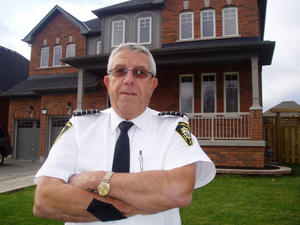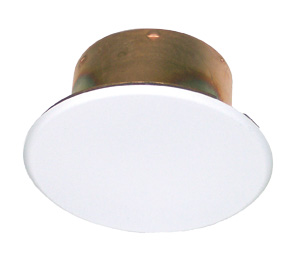
Features
Prevention
Building a better, safer home
Fire Chief Ken Beckett isn’t used to taking no for an answer. So when the builder hired to build his new home in East Gwillimbury, Ont., told him he couldn’t install sprinklers, Beckett went up the chain of command and convinced the company owner that sprinklers might take some extra work but, in this case, were a necessity.
November 17, 2008
By Blair Watson
Fire chief’s new abode helps to right myths about cost of residential sprinklers
 |
| Fire Chief Ken Beckett convinced the builder to alter plans and install sprinklers in his newly built home in East Gwillimbury, Ont. Photo courtesy Ken Beckett |
Fire Chief Ken Beckett isn’t used to taking no for an answer. So when the builder hired to build his new home in East Gwillimbury, Ont., told him he couldn’t install sprinklers, Beckett went up the chain of command and convinced the company owner that sprinklers might take some extra work but, in this case, were a necessity.
East Gwillimbury is a sleepy town near a busy Highway 400, about 30 kilometres northwest of Toronto. Beckett has been a firefighter for 47 years and retires in 2010. A major part of his retirement plan was to build a new home, which was completed in January.
Sprinklers are not required in Ontario for single-family detached homes but Beckett, a grandfather, knew the benefits of sprinklers compared to smoke alarms.
In Vancouver, where residential sprinklers have been mandatory since 1990, not a single sprinkler-equipped home has been lost to fire. Beckett was also aware that children sometimes sleep through a smoke alarms.
In 2006, A Channel in Barrie, Ont., produced and aired a multi-part news program called When Seconds Count, which is used by East Gwillimbury’s Emergency Services personnel to educate the public about home fire prevention. The program involved testing families to see if children would wake up after the smoke alarm went off and how long it would take family members to get out of the home. Many firefighters in Ontario have seen the program, which is on the A Channel website and won the Dave Rogers Award – Long Feature from the Association of Electronic Journalists in the Central Canada region two years ago.
A Channel reporter Jennifer Buchannan met with four families. At each home, City of Vaughan firefighters stationed members outside, beneath the children’s bedroom window in case they panicked during the test. Night vision cameras were placed in the bedrooms so viewers could see how each child reacted – if at all – to a smoke alarm. Fire Prevention Officer Andre Clafton activated a smoke machine in the hallway outside the bedrooms, setting off the overhead detector/alarm seconds later. Parents waited in their bedroom with Buchannan and her cameraman.
 |
| Residential sprinklers are more esthetically pleasing than commercial ones and are generally disguised with neutral-coloured coverings. Photo courtesy Fire Busters, Inc |
Clafton explained to viewers that occupants have about a minute to wake up and leave the residence once a fire has started. In the first house, David and Louie, ages five and eight respectively, were still asleep after 3.5 minutes despite the squawking alarm outside their bedroom. Finally, their parents, Tony and Elizabeth, could wait no longer and went into the boys’ bedroom to wake them. Almost five minutes passed before the family was out of the house.
In the second home, one of the seven-year-old boys awoke 10 seconds after the smoke alarm sounded. He called to his brother and then left his bedroom in a sleepy state of confusion, walking up and down the stairs four times, not knowing what to do. His twin brother eventually joined him. Clafton later said on camera that the boys would have been overcome by smoke.
In the home of the Iocono family, nine-year-old Joey not only slept through the smoke alarm beeping loudly in the hallway, he remained sleeping even after his parents entered his bedroom with the A Channel crew and turned on the overhead light. More than eight minutes after the alarm was activated by the smoke machine, Joey groggily left the home with his parents.
The stark reality of When Seconds Count was that the children would have died had the homes in which they were sleeping caught fire and no one got them out in time. The program showed that smoke alarms are not always adequate, depending on how deeply home occupants sleep. For Beckett, the solution to providing greater protection in his new house was obvious: sprinklers.
Because the Ontario Building Code had no regulations pertaining to home sprinklers, Beckett decided to use NFPA 13D: Standard for the Installation of Sprinkler Systems in One- and Two-Family Dwellings and Manufactured Homes, 2007 Edition. The standard is online on the National Fire Protection Association website at www.nfpa.org.
The process of getting a sprinkler system installed in Beckett’s new house involved educating the builder, who initially thought lawn sprinklers were desired. After realizing that Beckett wanted sprinklers inside the house, the builder’s response was that such an installation could not be done. Beckett decided to speak with the owner of the company, who had to be convinced that the unusual requirement could be met. He agreed to install the sprinkler system, which is monitored by an alarm response company and includes a loud horn heard not only by house occupants when activated, but the neighbours too.
The initial sprinkler system price from the builder was excessive, so Beckett met with him at the site of a home under construction to explain the fire load in a house. The builder then cut his cost in half. “Builders have to be educated on sprinkler systems and the myths that are out there,” Beckett said in an e-mail. “Fire Departments must get out and meet with sub-dividers and builders and educate them on residential sprinkler systems,” he added.
A sprinkler company laid out the design for the builder, who had to make some alterations to some of the bedrooms. One-inch-diameter pipe was required from the street main to the house (and to each sprinkler head), which involved an inspection from the municipality costing $100. Beckett said the cost per square foot of his new home for the sprinkler installation was $1.65.
In September, the NFPA’s Fire Protection Research Foundation (FPRF), released its Home Fire Sprinkler Cost Assessment report. The report was based on case studies that examined installation costs and insurance premium discounts associated with the installation of home fire sprinkler systems for 10 communities, nine in the U.S. and Pitt Meadows, B.C. According to the report, the cost of installing residential fire sprinklers averages $1.61 per square foot ($0.15 per square metre).
The cost to home builders of sprinkler systems per sprinklered square foot ranged from $0.38 to $3.66. All costs were taken into account, including system design and installation, permits, additional equipment, and increased tap and water meter fees, as applicable.
“There’s no question that an investment in a residential fire sprinkler system can prove to be a life-saving decision, but when seeking cost information to make that decision, people are often hard pressed to find true costs,” said Kathleen Almand, FPRF executive director. “We found that professionals in the field and the average person were in great need of reliable information in this area – the findings from our latest research project provide costs based on actual data.”
Blair Watson is a writer living in British Columbia.
Print this page